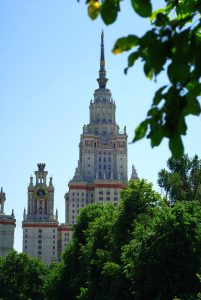Construction of the famous Moscow State University (MSU) began in 1949 and continued until 1953. It was connected with the need to create a new university that could provide high-quality higher education in the Soviet capital.
A high mountain in the southern part of Moscow was chosen for the construction of Moscow State University, which offered a panoramic view of the city. The project was headed by the architect Lev Rudnev, who developed the original design of the building, consisting of 36 buildings connected by bridges.
Thousands of workers, engineers and architects from all over the Soviet Union took part in the construction of Moscow State University.
Moscow State University (Unsplash License)
The Main Building of Moscow State University is one of the symbols of the Stalin era, its famous eight-pointed Stalinist high-rise hall with a height of 240 meters was the tallest building in Europe for decades. It is the most famous building of the university, its pediment with towers can be seen from many points of the city. It was the tallest building in Europe until the mid-1990s.
The MSU State Building houses a number of academic and scientific halls, auditoriums and laboratories, a library, a music hall, as well as conference halls and open spaces for students and teachers. The building also serves as a venue for scientific congresses, cultural events and forums.
The main building of Moscow State University is a symbol of Russia’s academic and scientific power. It has also become a popular tourist attraction, with many visitors coming to Moscow to see this famous building and enjoy the panoramic view of the city.
Today, MSU is one of the most prestigious universities in Russia and the world, known for its high scientific reputation, intellectual potential and extensive infrastructure. The MSU building is a cultural heritage site and a popular place for tourists and residents of Moscow. It is also often used as a backdrop for films and commercials.



